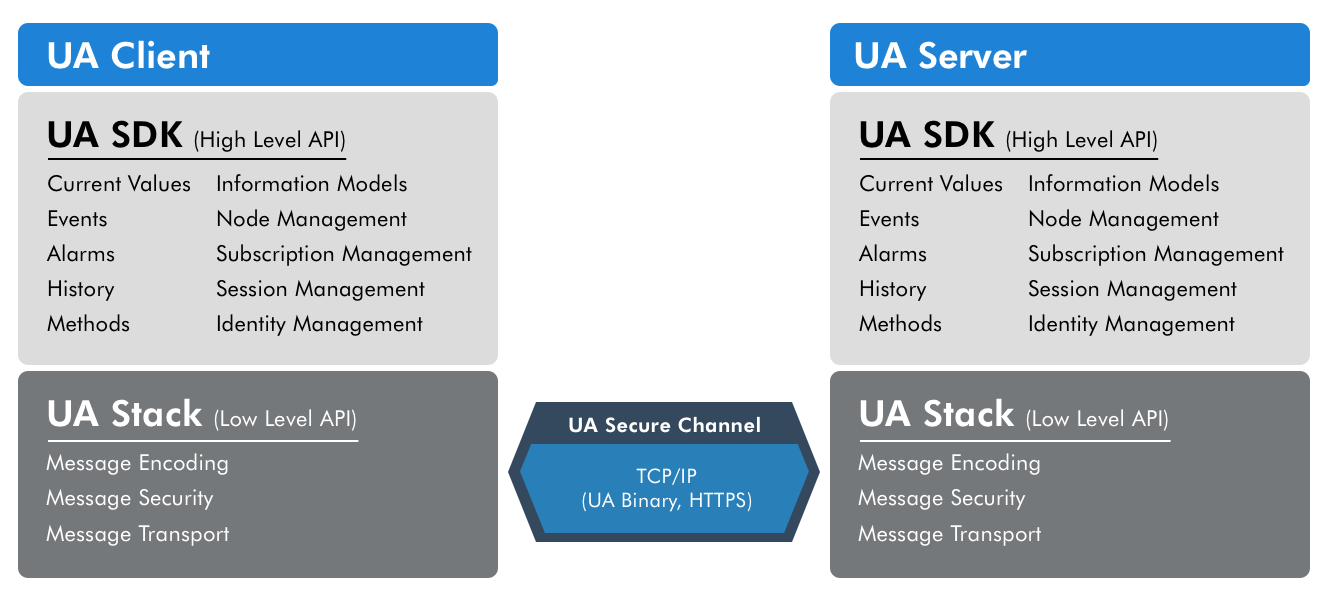About OPC UA
OPC UA (Unified Architecture) is a standardised communication protocol that enables secure Industrial Internet and Industry 4.0 solutions.
OPC UA (Unified Architecture) is a standardised communication protocol that enables secure Industrial Internet and Industry 4.0 solutions.
Whether you are working in process industry, manufacturing, machine control, power generation, smart grids or for example traffic management, with OPC UA you can integrate all your devices, automation systems and software applications using one secure and platform independent standard. Using OPC UA you can also build distributed Internet and cloud based systems connecting your remote devices and I/O to a core server and database, allowing device diagnostics, asset management, monitoring, reporting and other applications.
With OPC UA you can make your products interoperable with products of other vendors, thus enabling your customers to build total systems. Using a standardized and secure communications technology makes the integration more reliable and cuts your costs as you only need to implement one standard interface. Furthermore, Industrial Internet and Internet of Things (IoT) are a strong trend, and OPC UA offers you a good communication protocol when you develop your own products and systems fitting into that framework.
When you integrate systems of multiple vendors to provide total solutions to your customers, you want to use standardized, reliable, secure, scalable and platform independent technology. This is what OPC UA offers to you. Furthermore, its continuous development is ensured by over 450 international members of OPC Foundation. When you select OPC UA as your core system integration technology, you can use your software and professional knowledge over and over again, executing your projects economically and on schedule.
One of the key features of successful enterprise software is how interfaces to other systems are implemented. For HMI, SCADA, MES and ERP, monitoring, quality control and reporting, and for numerous other software applications, OPC UA offers a solution to the integration challenge in a productive way. When you develop your own software, you want to maximize the number of possible customers while ensuring high quality, and both are achieved by offering OPC UA as a standard interface included in your software.
OPC UA is the new generation of OPC (classic) and is the standard communication and system integration protocol for automation, Industrial Internet, Internet of Things and Industry 4.0 solutions.
Improvements in OPC UA:
OPC UA application software development is based on a layered architecture. OPC UA stacks implement the TCP/IP communication protocol defined by OPC Foundation. There are different stacks for different programming languages and environments, including ANSI C Stack, .NET Stack and Java Stack. Prosys OPC is the major contributor to the Java Stack.
The different OPC Foundation stacks are interoperability tested, so you can use your OPC UA application with other OPC UA applications, independent of the programming language and development environment in which they are created.
OPC UA Stacks are provided by OPC Foundation and they are available to the members of the OPC Foundation and nowadays also as open source downloads. The stacks are also included in the SDK distributions of vendors such as Prosys OPC. The license from OPC Foundation enables our SDK customers to distribute stacks with their own applications.
Although the stack makes all OPC UA service calls available, another layer is required on top of it. The services of the OPC UA servers are expected to function in a certain way, and the OPC UA client applications must also implement certain infrastructure to enable full use of the OPC UA protocol. These features are typically available in OPC UA SDK products, such as Prosys OPC UA SDK for Java.
The following picture depicts the functionalities of the OPC UA stack and the SDK. In principle, the stack handles the communication protocol, whereas the SDK implements the base services. The services are more important on the server side, but there is certain infrastructure that needs to be taken care of also on the client side.

Using OPC UA communications enables different application across many industries. These applications typically do not require programming skills and tools. Instead they usually include configurators, which allow engineers and IT experts to make a suitable setup for their use case.
Typical applications using OPC UA communications:Industry 4.0 is a German initiative for future development of industrial IT, which is currently revolutionizing the manufacturing engineering sector. Industry 4.0 refers to the technological evolution from embedded systems to cyber-physical systems (CPS) and represents the coming fourth industrial revolution on the way to Industrial Internet of Things (IIoT), Data and Services. Cyber-physical systems are enabling technologies which bring the virtual and physical worlds together to create a truly networked world in which intelligent objects communicate and interact with each other. In Industry 4.0 machines communicate with machines and autonomously manage production in a flexible, efficient and resource saving manner.
When developing Industry 4.0 and Industrial Internet of Things (IIoT) solutions, secure and standardized exchange of data and information between devices, machines and services is needed. The Reference Architecture Model for Industry 4.0 (RAMI 4.0) recommends only IEC standard 62541 OPC Unified Architecture (OPC UA) for implementing the communication layer. To comply with the Industry 4.0 communication specification, devices, machines and systems need to be addressable over the network via TCP/UDP or IP and to implement at least the OPC UA information model. As a result, any product classified as Industry 4.0 compatible must have OPC UA, either integrated or using a gateway product.